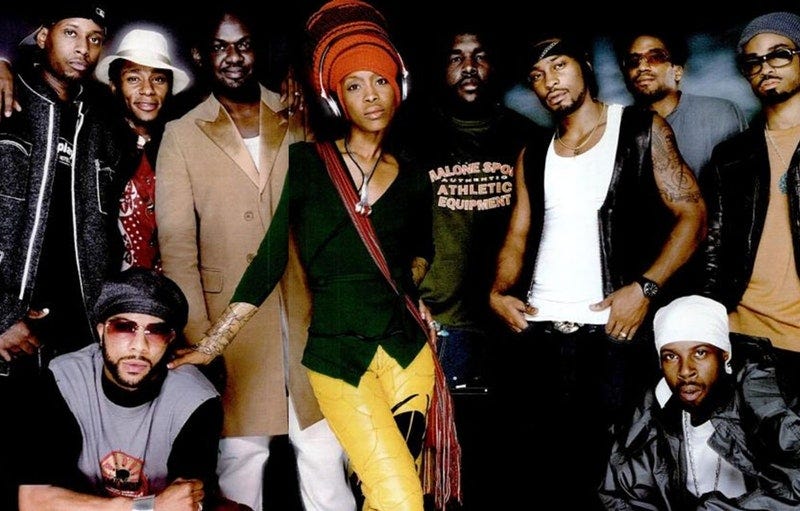🚨LISTEN TO THE CLIP BEFORE YOU READ THE ARTICLE🚨

Back in 2012 on the dearly-departed The Champs Podcast, the immortal Questlove laid out the strategy for what became The Soulquarians, a loose collective of musicians that dominated rap and R&B in the late-90s and early 2000’s. What he says in this clip is the secret behind creating a “movement”. That secret is the driving force behind every major music movement over the past 30 years.
For the sake of understanding, a “movement” in this context means a marketing campaign around a specific piece of art that aims to provide community, affiliation and inspiration as well as the desire to live a better life. Let’s first unpack how they did it.
The Soulquarians — an unofficial collective consisting of Erykah Badu, Bilal, Common, D'Angelo, Talib Kweli, Mos Def, Pino Palladino, James Poyser, Q-Tip, Questlove himself and his Roots bandmates, and the late Roy Hargrove and J Dilla — were all established artists at the time but by adding a cultural context to their output, they all achieved more success than they would have going about it all separately. The collective produced and guested on each others albums and in doing so, shaped the sound of hip-hop, soul and R&B across the 11-12 albums they worked on during their short time together.
As he mentions in the clip, by framing the Soulquarians collective as “alternative, left-of-center hip-hop”, Questlove and his label were able to poach other acts that matched The Roots’ sound as well as allowed them to collaborate freely to create music that fit in that “alternative hip-hop” pocket by using a specific context that fans could identify with, even if they had never listened to an album.

The Soulquarians, from left: Talib Kweli, Common, Yasiin Bey, James Poyser, Erykah Badu, Questlove, Q-Tip, Bilal and J. Dilla
A reminder: The music business is trying to sell a product. That product = the songs they own and the people who make them. As a creative, it can be easy to focus solely on the work itself without considering the cultural context of how potential fans will be introduced to you and your “product” in the first place. From there, it’s easier to get press opportunities (Trust me, it’s ridiculously easier to get coverage if you have your movement already rolling) and agents and marketing types know how to market you amongst the thousands of people who are trying to do the same thing you are.
Cultural context is my fancy way to describe the “movement” concept.
What is “cultural context”?
To me, cultural context is the unique cultural perspective of a product presented in the proper context the creator intended it to be consumed in. Going back to the music example, the product (music) and the people who make it are created and inspired by specific cultures, based on whatever traditions they have inherited along with unique personal touches like regional slang, or a particular style of production. Music is a great example of this phenomenon, because all music must grow out of its own cultural context. People in every culture create music, based on what they’ve learned and from what they’ve listened to growing up. Even when an artist creates something entirely new, it is still based on a cultural context of what existed before. Cultural context in music is why you know what the British Invasion is or what a Motown song sounds like. It’s why people spend all day on Twitter going to war for southern rap, grime, noise, black metal or Gqom. Cultural context is why Dreamville is winning right now. It’s the combination of the unique cultural experiences of the people making the music presented in proper context.
This concept isn’t new by the way. My main man Emile Durkheim — one of the people responsible for the study of social science itself — talked about this in 1893.

*pulls out Social Sciences degree*
The “movement” concept aligns with Durkheim’s notion of mechanical solidarity.
Mechanical solidarity is the sense of togetherness in a society that arises when people share similar experiences, customs, values, and beliefs. Mechanical solidarity is a form of social cohesion, in which people are bound together for a passionate cause with a sense of common duty and responsibility, which, in turn, can spark cultural movement. Cultural contexts power these movements and by doing so, enhance group solidarity, strengthen our identities and social solidarity, as well as bring people and societies together.
Now, using the music example, I’ll share steps to create your own “movement”:
Ask yourself, “What do I want to share with the world about me and the people who live in my world via my art?”
Look around and find people who share your culture who are in a similar creative space. Start in your backyard because odds are, those people will get what you’re trying to do because they share similar context.
Collaborate on projects that appeal to people who share your cultural context with people who share your cultural context.
Broaden your reach by figuring out how to contextualize your culture to someone who is completely different from you. (A good way to do this is to think about what questions a journalist would ask you about your creative output. Try to answer questions like “What do I have to say about the world?” And “What did growing up in _____ teach me about music?” The better you can articulate your context, the better chance a person has to understand and ultimately support what you’re trying to do.
Repeat until you have a million in the bank.
If you’re a creative in any discipline, I’d advise taking a look at the culture that created you and then looking around for like-minded individuals who share your cultural context. Odds are, they have the same goals as you do.
As the old saying goes, if you want to go far, go together.
If you enjoyed this article, I hope you’ll consider a paid subscription. Paid subscriptions allow for a better newsletter and more value for you lovely subscribers.
Your Homework for the Week:
Wesley Morris makes me want to retire from writing because I can’t do cultural commentary this good😞
TUNES:
For more on the Soulquarians, check out Okayplayer and the late great RBMA’s stories on the collective. Also, this playlist SLAPS.
If you enjoyed this story, forward to a friend and tell them to sign up for the newsletter!
Office Hours is written by Ernest Wilkins.Follow me everywhere @ErnestWilkins or email me here.









